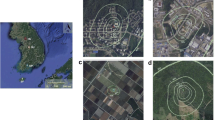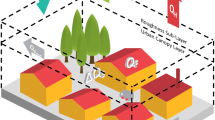Abstract
Interpretation of tower-based eddy covariance (EC) carbon dioxide flux (F C ) measurements in urban areas is challenging because of the location bias of EC instruments. This bias results from EC point measurements taken above a complex CO2 source/sink surface that is spatially heterogeneous at scales approaching or exceeding those of the turbulent flux source areas. This makes it difficult to accomplish traditional measurement objectives such as calculating spatially unbiased ecosystem-wide cumulative F C totals or objectively comparing F C during different environmental conditions (e.g., day vs. night or seasonal differences). This study uses a multiyear F C dataset measured over a residential area of Vancouver, BC, Canada from a 30-m flux tower in close proximity to a busy traffic intersection on one side. The F C measurements are analyzed using surface geospatial data and turbulent flux source area models to exploit location bias to develop methods to statistically model individual emissions and uptake processes in terms of environmental controls and surface land cover. The empirical relations between controls and measured F C are used to spatially and temporally downscale individual CO2 emissions/uptake processes that are then used to create high-resolution maps (20 m) and calculate ecosystem-wide F C at temporal resolutions of 30 min to 1 year. At this site, the modeled ecosystem-wide annual net F C total is calculated as 6.42 kg C m−2 year−1 with traffic emissions estimated to account for 68.8 % of the total net emissions. Building sources contribute 27.9 %, respiration from soil and vegetation is 5.5 %, respiration from humans 5.0 %, and photosynthesis offsets are −7.2 % of the annual net total. The statistical models developed here are then tested by direct comparison to independent EC measurements using land cover scalings derived from 30-min source area models. Results are also scaled to ecosystem-averaged land cover to compare results to independent emissions/uptake models.










Similar content being viewed by others
References
ASHRAE (2004) Ventilation for acceptable indoor air quality. Technical report. American Society of Heating, Refrigeration, and Air-Conditioning Engineers, Inc.
Aubinet M, Vesala T, Papale D (eds.) (2012) Eddy covariance: a practical guide to measurement and data analsysis. Springer Atmospheric Sciences
Bates D, Watts D (1988) Nonlinear regression analysis and its applications, vol 2. Wiley Online Library
Bergeron O, Strachan IB (2011) CO2 sources and sinks in urban and suburban areas of a northern mid-latitude city. Atmos Environ 45(8):1564–1573
Campbell GS, Norman JM (1998) Introduction to environmental biophysics. Springer Verlag
Chen B, Black T, Coops N, Hilker T, Trofymow J, Morgenstern K (2009) Assessing tower flux footprint climatology and scaling between remotely sensed and eddy covariance measurements. Bound Layer Meteorol 130(2):137–167
Christen A, Coops N, Crawford B, Kellett R, Liss K, Olchovski I, Tooke T, van der Laan M, Voogt J (2011) Validation of modeled carbon-dioxide emissions from an urban neighborhood with direct eddy-covariance measurements. Atmos Environ 45(33):6057–6069
City of Vancouver (2012) Vanmap. http://vancouver.ca/your-government/vanmap.aspx. Accessed 29 May 2013
Cleugh H, Oke T (1986) Suburban-rural energy balance comparisons in summer for Vancouver.Bound Layer Meteorol 6(4):351– 369
Counehan J (1971) Wind tunnel determination of the roughness length as a function of the fetch and the roughness density of three-dimensional roughness elements. Atmos Environ 5(8):637–642
Crawford B, Christen A (2012) Quantifying the CO2 storage flux term in urban eddy-covariance observations. In: 8th international conference on urban climates. Dublin
Crawford B, Christen A, Ketler R (2010) Eddy covariance data processing and quality control procedures, EPiCC Technical Report No. 1, p 11. https://circle.ubc.ca/handle/2429/45079
Crawford B, Grimmond C, Christen A (2011) Five years of carbon dioxide fluxes measurements in a highly vegetated suburban area. Atmos Environ 45(4):896–905
Environment Canada (2013) http://www.climate.weatheroffice.gc.ca/Welcome_e.html. Accessed 29 May 2013
Falge E, Baldocchi D, Tenhunen J, Aubinet M, Bakwin P, Berbigier P, Bernhofer C, Burba G, Clement R, Davis KJ et al (2002) Seasonality of ecosystem respiration and gross primary production as derived from fluxnet measurements. Agric For Meteorol 113(1):53–74
Goodwin N, Coops N, Tooke T, Christen A, Voogt J (2009) Characterizing urban surface cover and structure with airborne lidar technology. Can J Remote Sens 35(3):297–309
Grimmond C, King T, Cropley F, Nowak D, Souch C (2002) Local-scale fluxes of carbon dioxide in urban environments: methodological challenges and results from Chicago. Environ Pollut 116:243–254
Grimmond CSB, Oke TR (1991) An evapotranspiration-interception model for urban areas. Water Resour Res 27(7):1739–1755
Hiller RV, McFadden JP, Kljun N (2011) Interpreting CO2 fluxes over a suburban lawn: the influence of traffic emissions. Bound Layer Meteorol 138(2):215–230
Järvi L, Nordbo A, Junninen H, Riikonen A, Moilanen J, Nikinmaa E, Vesala T (2012) Seasonal and annual variation of carbon dioxide surface fluxes in Helsinki, in 2006–2010. Atmos Chem Phys 12:8475–8489
Kellett R, Christen A, Coops NC, van der Laan M, Crawford B, Tooke TR, Olchovski I (2012) A systems approach to carbon cycling and emissions modeling at an urban neighborhood scale. Landscape and urban planning
Kordowski K, Kuttler W (2010) Carbon dioxide fluxes over an urban park area. Atmos Environ 44(23):2722–2730
Kormann R, Meixner F (2001) An analytical footprint model for non-neutral stratification. Bound Layer Meteorol 99(2):207–224
Kotthaus S, Grimmond C (2012) Identification of micro-scale anthropogenic CO2, heat and moisture sources—processing eddy covariance fluxes for a dense urban environment. Atmos Environ 57(301):e316
Liss K, Crawford B, Christen A, Siemens C, Jassal R (2009) Ecosystem respiration of suburban lawns and its response to varying management and irrigation regimes. In: American meteorological society annual meeting. Phoenix
Liss K, Tooke RNC, Christen A (2010) Vegetation characteristics at the Vancouver EPiCC experimental sites. EPiCC Technical Report No. 3. https://circle.ubc.ca/handle/2429/45078
Lloyd J, Taylor J (1994) On the temperature dependence of soil respiration. Funct Ecol:315–323
Lutsey N, Sperling D (2008) America’s bottom-up climate change mitigation policy. Energy Policy 36(2):673–685
Matese A, Gioli B, Vaccari F, Zaldei A, Miglietta F (2009) Carbon dioxide emissions of the city center of Firenze, Italy: measurement, evaluation, and source partitioning. J Appl Meteorol Climatol 48(9):1940–1947
Ministry of Transportation (2004) Greater Vancouver trip diary survey. Technical report, British Columbia ministry of transportation
Moore C (1986) Frequency response corrections for eddy correlation systems. Bound Layer Meteorol 37(1):17–35
Moriwaki R, Kanda M (2004) Seasonal and diurnal fluxes of radiation, heat, water vapor, and carbon dioxide over a suburban area. J Appl Meteorol 43(11):1700–1710
Nemitz E, Hargreaves KJ, McDonald AG, Dorsey JR, Fowler D (2002) Micrometeorological measurements of the urban heat budget and CO2 emissions on a city scale. Environ Sci Tech 36(14):3139–3146
Nordbo A, Järvi L, Haapanala S, Wood CR, Vesala T (2012) Fraction of natural area as main predictor of net CO2 emissions from cities. Geophys Res Lett 39:L20802
Nowak DJ (1996) Notes: estimating leaf area and leaf biomass of open-grown deciduous urban trees. For Sci 42(4):504–507
Ögren E, Evans J (1993) Photosynthetic light-response curves. Planta 189(2):182–190
Pawlak W, Fortuniak K, Siedlecki M (2011) Carbon dioxide flux in the centre of Łódź, Poland—analysis of a 2-year eddy covariance measurement data set. Int J Climatol 31(2):232–243
Peters EB, McFadden JP (2012) Continuous measurements of net CO2 exchange by vegetation and soils in a suburban landscape. J Geophys Res 117:G03005
Raupach M, Rayner P, Paget M (2010) Regional variations in spatial structure of nightlights, population density and fossil-fuel CO2 emissions. Energy Policy 38(9):4756–4764
Reichstein M, Falge E, Baldocchi D, Papale D, Aubinet M, Berbigier P, Bernhofer C, Buchmann N, Gilmanov T, Granier A et al (2005) On the separation of net ecosystem exchange into assimilation and ecosystem respiration: review and improved algorithm. Glob Chang Biol 11(9):1424–1439
Reid K, Steyn D (1997) Diurnal variations of boundary-layer carbon dioxide in a coastal city—observations and comparison with model results. Atmos Environ 31(18):3101–3114
Roth M, Oke TR (1995) Relative efficiencies of turbulent transfer of heat, mass, and momentum over a patchy urban surface. J Atmos Sci 52:1863–1874
Sailor D, Lu L (2004) A top-down methodology for developing diurnal and seasonal anthropogenic heating profiles for urban areas. Atmos Environ 38(17):2737–2748
Satterthwaite D (2008) Cities’ contribution to global warming: notes on the allocation of greenhouse gas emissions. Environ Urban 20(2):539–549
Schmid H (1994) Source areas for scalars and scalar fluxes. Bound Layer Meteorol 67(3):293–318
Schmid H, Lloyd C (1999) Spatial representativeness and the location bias of flux footprints over inhomogeneous areas. Agric For Meteorol 93(3):195–209
Schmid H, Cleugh H, Grimmond C, Oke T (1991) Spatial variability of energy fluxes in suburban terrain. Bound Layer Meteorol 54(3):249–276
Statistics Canada (2011) Census tract dissemination. http://www12.statcan.gc.ca/census-recensement/2011/geo/map-carte/ref/CT-SR-eng.cfm?PRCODE=59&CACODE=933. Accessed 29 May 2013
Stewart ID, Oke TR (2012) Local climate zones for urban temperature studies. Bull Am Meteorol Soc 93(12):1879–1900
Steyn D, Faulkner D (1986) The climatology of sea-breezes in the lower fraser valley.Climatol Bull 20(3):21–39
Teske ME, Thistle HW (2004) A library of forest canopy structure for use in interception modeling. For Ecol Manag 198(1):341– 350
Tooke T, Coops N, Goodwin N, Voogt J (2009) Extracting urban vegetation characteristics using spectral mixture analysis and decision tree classifications. Remote Sens Environ 113(2):398–407
UN (2011) World urbanization prospects, the 2011 revision. http://esa.un.org/unpd/wup/CD-ROM/Urban-Rural-Population.htm. Accessed 29 May 2013
van der Laan M (2011) Scaling urban energy use and greenhouse gas emissions through LiDAR, Master’s thesis, University of British Columbia
Velasco E, Roth M (2010) Cities as net sources of CO2: review of atmospheric CO2 exchange in urban environments measured by eddy covariance technique. Geogr Compass 4(9):1238–1259
Velasco E, Pressley S, Allwine E, Westberg H, Lamb B (2005) Measurements of CO2 fluxes from the Mexico City urban landscape. Atmos Environ 39(38):7433–7446
Velasco E, Roth M, Tan S, Quak M, Nabarro S, Norford L (2013) The role of vegetation in the CO2 flux from a tropical urban neighbourhood. Atmos Chem Phys Discuss 13:7267–7310
Villar R, Held AA, Merino J (1995) Dark leaf respiration in light and darkness of an evergreen and a deciduous plant species. Plant Phys 107(2):421–427
Vogt R, Christen A, Rotach M, Roth M, Satyanarayana A (2006) Temporal dynamics of CO2 fluxes and profiles over a Central European city. Theor Appl Climatol 84(1):117–126
Walsh C (2005) Fluxes of radiation, energy, and carbon dioxide over a suburban area of Vancouver, Master’s thesis. Department of Geography, University of British Columbia
Webb E, Pearman G, Leuning R (1980) Correction of flux measurements for density effects due to heat and water vapour transfer. Q J R Meteorol Soc 106(447):85–100
Acknowledgments
The current research was funded by the Canadian Foundation for Climate and Atmospheric Sciences (CFCAS) as part of the network Environmental Prediction in Canadian Cities (EPiCC) and by an NSERC Discovery Grant “Direct measurement of greenhouse gas exchange in urban ecosystems.” Selected research infrastructure on the tower was supported by NSERC RTI and CFI/BCKDF. We acknowledge the support of the City of Vancouver and Environment Canada for providing additional data and BC Hydro for granting access to the tower site.
We further acknowledge the significant scientific, technical, and administrative support of staff and students at the University of British Columbia in providing remote sensing data, geospatial data and supporting the technical aspects of the long-term measurements: N. Coops, N. Goodwin, E. Heyman, R. Ketler, S. Lapsky, K. Liss, Z. Nesic, J. Ranada, C. Siemens, M. van der Laan and R. Tooke.
Author information
Authors and Affiliations
Corresponding author
Rights and permissions
About this article
Cite this article
Crawford, B., Christen, A. Spatial source attribution of measured urban eddy covariance CO2 fluxes. Theor Appl Climatol 119, 733–755 (2015). https://doi.org/10.1007/s00704-014-1124-0
Received:
Accepted:
Published:
Issue Date:
DOI: https://doi.org/10.1007/s00704-014-1124-0




